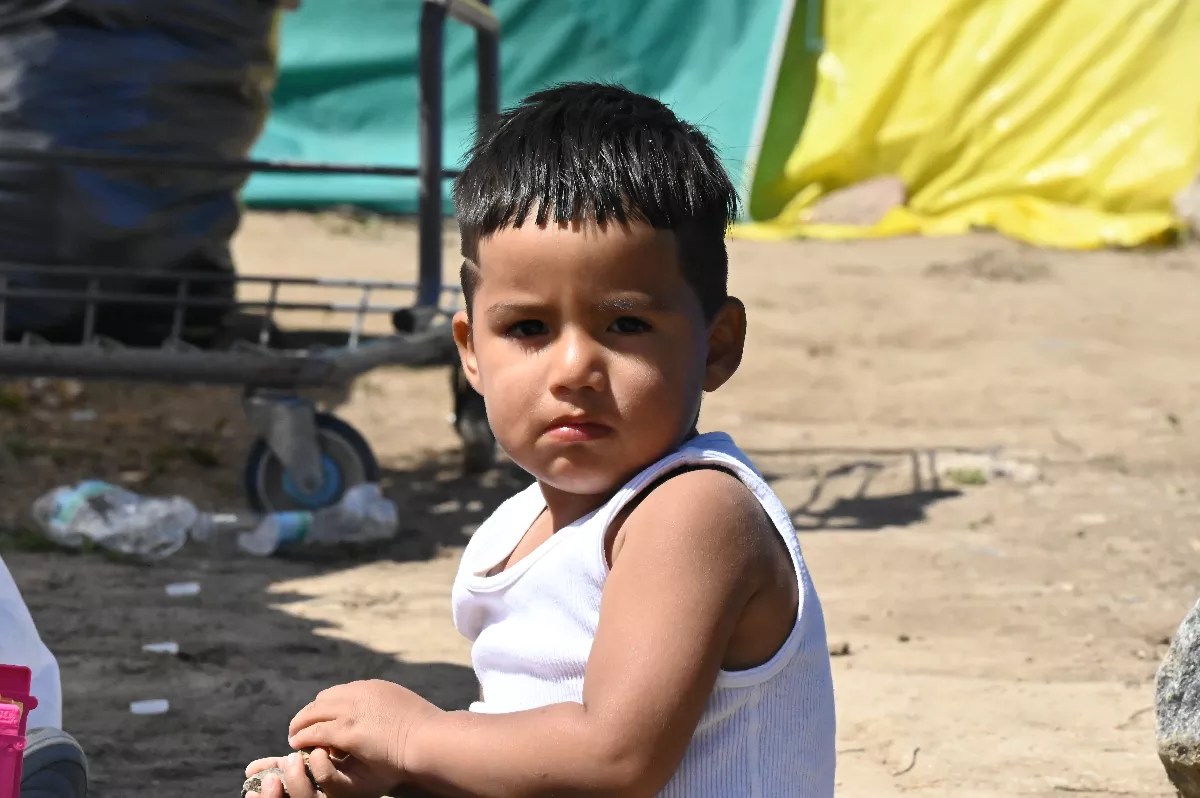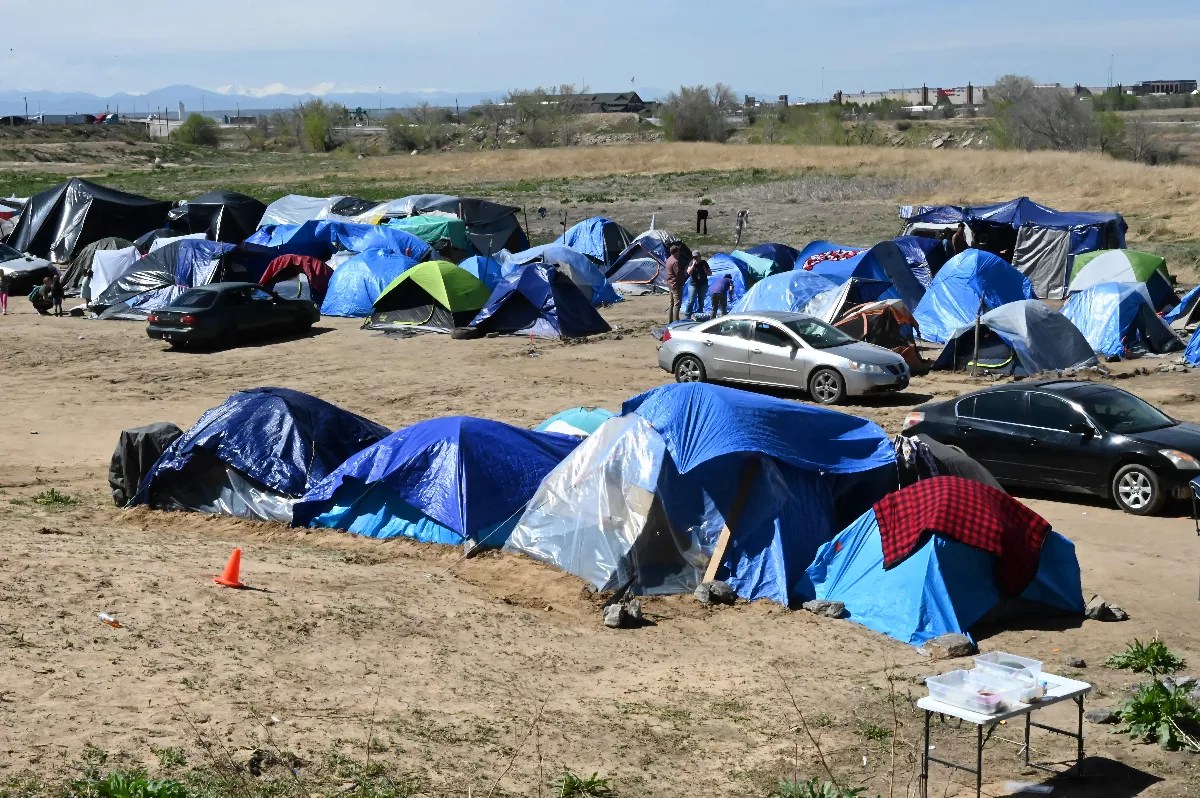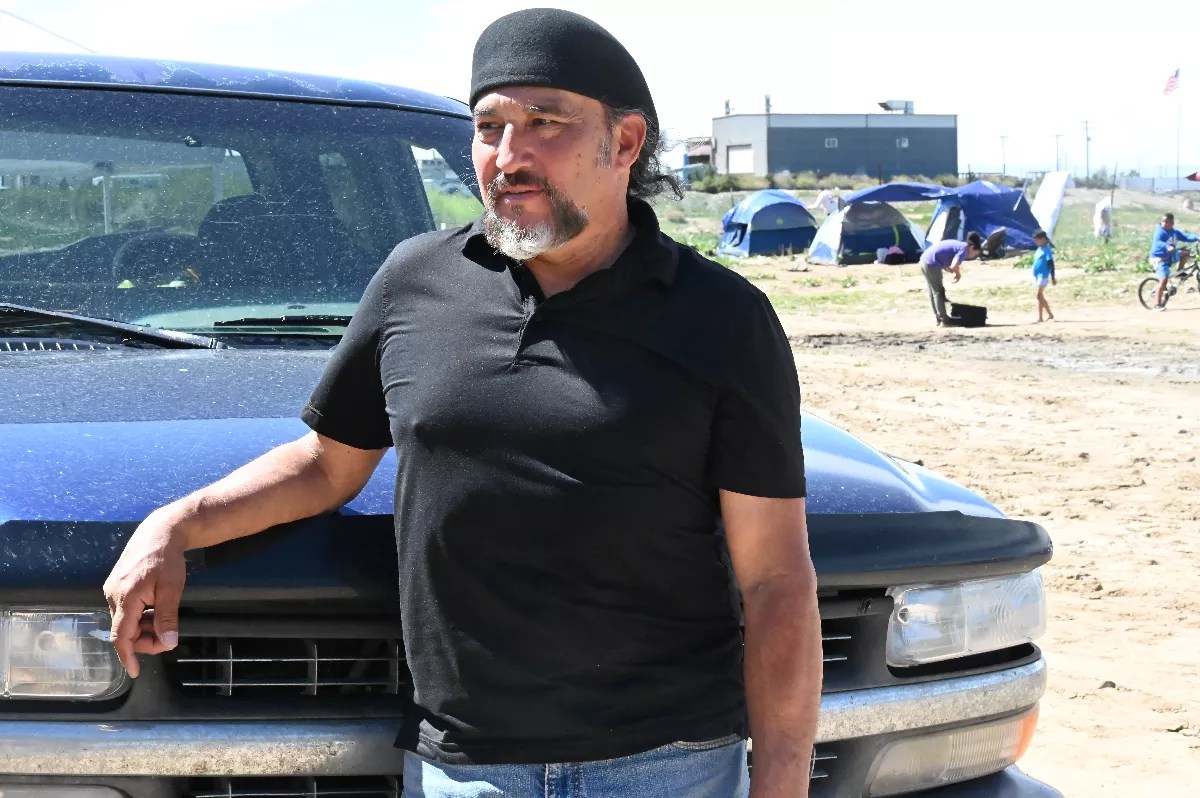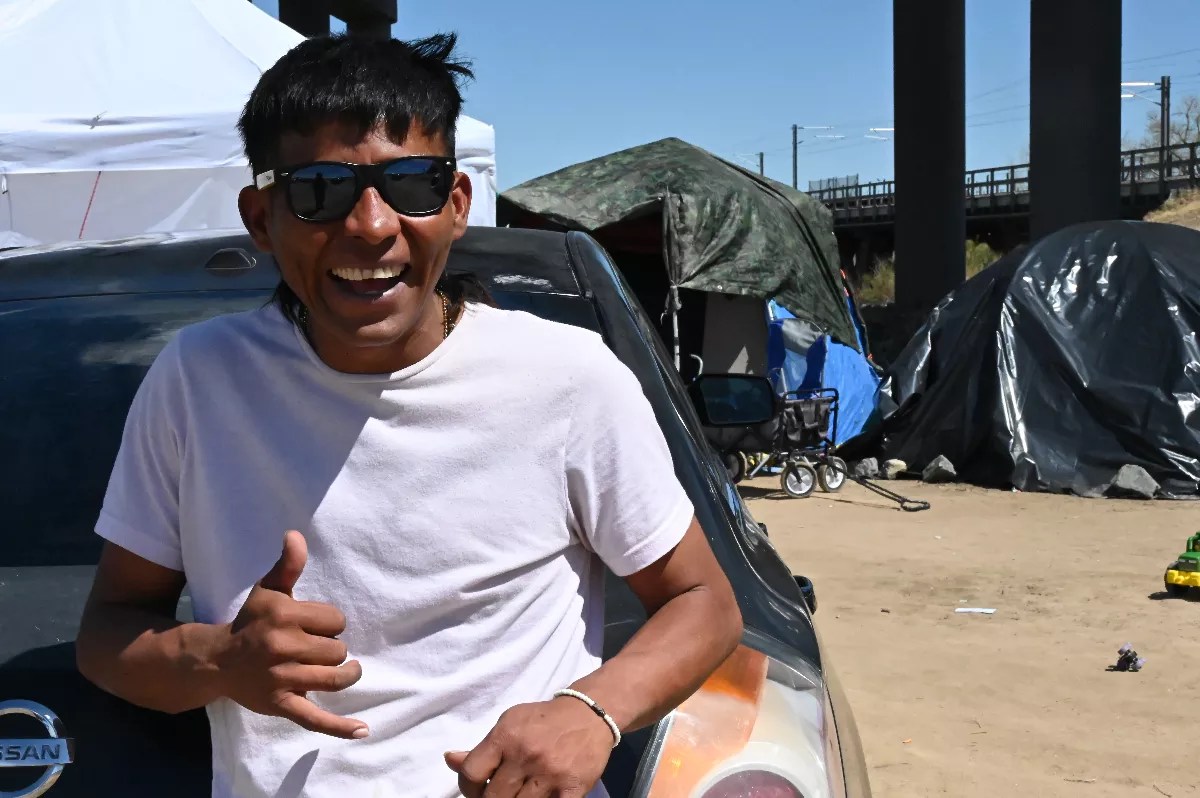
Bennito L. Kelty

Audio By Carbonatix
Under the afternoon sun on a dry patch of land at the end of April, Arthur Infante bounces back and forth across a dusty migrant encampment he’d set up in March, getting people air pumps, tent stakes, propane tanks, water jugs, heating equipment and bubbles for the kids.
“The interesting thing is there are a lot of kids, and they’re happy, not a care in the world with them,” Infante says. “They don’t know their situation. They’re like, ‘You got bubbles for me?’ That’s their main concern.”
The local sculptor works with All Souls Denver, a nonprofit that supports encampments, but Infante also cares for migrants and homeless residents through his organization My Mother’s Kitchen. For thirty years, he’s been giving out food and everyday supplies from the back of his pickup truck. More recently, he’s been building and maintaining encampments.
In November, he began working with migrants, too.
Denver, make your New Year’s Resolution Count!
We’re $10,000 away from reaching our $50,000 year-end fundraising goal. Your support could be what pushes us over the top. If our work has kept you informed and connected this year, please consider making a contribution today.
Infante has opened and operated four migrant encampments so far, he says, including two on Tower Road. In late March, he built the foundation for a migrant encampment in Central Park, located in the middle of a bare stretch of grass and dirt road under a four-lane overpass. It’s tucked into a spot where a creek and railroad pinch together, next to jagged rocks that take up the shade of the overpass, while the rest of the hills and green grass stretch behind a fence, to the back of warehouses and unfinished construction projects.
Union Pacific, the railroad company that owns the property, posted a notice on April 22 that the encampment will be swept on Monday, May 6. The company will work with the city to clear the encampment that day, Union Pacific spokesperson Mike Jaixen says.
“Not only is trespassing on railroad property illegal, it is dangerous to be setting up camps within a few feet of railroad tracks,” Jaixen says. “For their safety, we’re asking everyone in this camp to please leave railroad property.”
Infante says that once the city and Union Pacific sweep the encampment, he’ll build another and keep it hidden as long as possible, as he did with this one.
Denver Human Services spokesperson Jon Ewing says the city isn’t interested in playing cat-and-mouse with Infante.
“When we are not aware of an encampment, or where it is located, it is all but impossible for us to help,” he says. “We have too much going on to play games, especially when it comes to people’s lives.”
The encampment sits at the foot of a hill that has Union Pacific tracks on top, with no barrier between them. When it opened more than a month ago, the encampment housed about twenty people, but the head count has grown to more than ninety, including nineteen children. The City of Denver estimates that 73 people are at the encampment, including sixteen kids, a couple of teenagers and at least two pregnant women.
A handful of migrants have cars parked there, none with license plates. While kids blow bubbles or ride on bikes through the dirt in the middle of the encampment, people continue asking Infante for various tools and supplies – and even though Infante could reach into the back of his pickup truck for just about anything, he comes up short of a car jack.
With campers asking for things every few minutes, it’s easy to forget requests for trash bags or brooms, but Infante does his best to keep everything from food and sanitation items to phone-charging stations in his truck.
There is one big obstacle, however.
“I’m fumbling through with my Spanish,” Infante says, admitting he doesn’t speak the language. On this day, a team of service workers from various homeless organizations happen to be there, so he asks them to translate (as he does the Westword journalist walking alongside him).

The number of people at the migrant encampment in Central Park is estimated to be between seventy and ninety.
Bennito L. Kelty
Many of the migrants in the encampment say they have stayed in city shelters and either didn’t like it or exhausted the time limit the city gave them, which for some was more than 42 days. Others skipped the shelters and went straight to living on the streets.
FaBiola Pineda arrived from Venezuela in Denver three months ago with her partner and three-year-old daughter. She stayed in a city migrant shelter during a stretch of cold weather that kept her there for more than 42 days. They were discharged in February, and she lived on the streets until she found the Central Park encampment.
“A friend told us, and she brought us here. I only have about seven days that I’ve been here,” Pineda says. “They say the women here are allowed to work in construction, and I did that in Venezuela. I don’t know about here, but if I get the chance, I’d do that.”
Most of the migrants at the encampment are with family members, Infante says. Singles stay in one part while families have a section reserved for them. According to Ewing, “There are many in the encampment that have been in the U.S. for some time” and “there may be some who bypassed the shelter system entirely.”
Some residents of the encampment walked across Denver after being swept from a site outside Elitch Gardens in late March, Infante says. The rest of them mostly followed Infante from an encampment he’d built near West 48th Avenue and Fox Street, under a bridge closer to downtown, before it was swept in January.
The Central Park encampment hid under the city’s nose for almost a month. In fact, Denver officials didn’t know that Infante has been building migrant encampments until the Central Park site was discovered last week after Union Pacific reps and nearby residents reported it.
According to Ewing, keeping encampments secret also keeps Denver Human Services from helping the migrants there.
“People involved with the encampment wouldn’t communicate any details around it, down to the location, so we couldn’t do any outreach,” Ewing says. “Because this encampment was kept from us, we’re now getting started on providing outreach to every single person staying there. At the end of the day, we don’t feel like you walk thousands of miles to this country to live in a tent, so we’re going to do everything in our power to help them out.”
the city typically receives information about encampments from migrants seeking city services or local residents supporting an encampment. “For example, we had a really good relationship with folks involved with the Elitch camp,” Ewing says. “If a family showed up, we could immediately drop by and help.”
Infante says he understands Union Pacific’s concern, and adds that the company has been “really nice” about moving the encampment along. But he doesn’t feel the same way about the city.
“They ended up giving us some time,” Infante acknowledges, then adds: “The city is the one who comes out with cops.”
Infante recently began handing out bus passes provided by the Department of Public Health & Environment, but he’s out at the moment – so most of the migrants at the encampment, like Emerson Villareal, don’t know where they’re going after their tents are swept on May 6.
“We’ll wait until the scheduled day to see where we’ll go,” Villareal says. “All of us will leave together.”
Infante expects to build another encampment where people can go.
“We’re still looking for places,” Infante says. “We have, like, three different places we’re hoping for, but we’re trying to hide it because we get swept if people know. We can’t bring in volunteers, because then they say, ‘Oh, we helped out here,’ and then we get swept the next day.”

Arthur Infante, a Denver artist, built up and took care of a migrant encampment in Central Park, and he plans to do it again.
Bennito L. Kelty
While he landed on Union Pacific turf this time, Infante tries to stick to city property and “land that is away from people, that’s not in a neighborhood,” he says.
“We look at drainage so we can put tents where there’s not a flooding issue,” he adds. “Fire safety is a huge thing, because we use small propane tanks – nothing large, so we make sure there’s no vegetation around or close by.”
Each encampment has gotten larger, according to Infante, and each one has more kids than the last. He says he’s never tried to manage a site as large as the Central Park encampment.
At this site, he set up three tents to operate as kitchens – two family kitchens and one for individuals. He dug trenches to make sure that water flows out when it rains or snows, instead of pooling up under everyone’s tents. He also taught a few migrants to dig latrines, one for the women and one for the men.
Migrants stopped using the latrines after the site was discovered and the city brought four porta-potties. For trash, Infante fills large Walmart grocery bags, piles them next to the bathrooms and takes the load with him in his pickup at the end of the day.
He also keeps a census of everyone at the encampment. Each tent has a number so Infante can track who’s living there. For safety, he takes pictures of every car that comes into the encampment via a dirt road.
In the main kitchen, where Infante keeps a picture of his mother (hence the name My Mother’s Kitchen), he tailors food to the tastes of Venezuelans, who have a tough time finding food they like in Denver.
“I’ll make a caldo-type stew that they recognize everything in there. Sometimes people bring something and they don’t recognize it; they’ll recognize the chicken or the carrots, but they will not eat it,” he says. “They won’t eat burritos or tacos either, nothing spicy. They’re like the Norwegians of South America: no spice, plain as day.”
A couple of men at the encampment had chicken pox last month, so the city is now offering vaccinations to migrants. A group from Denver Street Outreach shows up unexpectedly, too. Sarah Plastino, the director of Denver’s newcomer program, has come twice since the site was discovered to bring water and talk to people.

Emerson Villareal doesn’t know where he’s going after his tent is swept on Monday, but he says everyone will leave together.
Bennito L. Kelty
Three Americans have stayed at the encampment so far, Infante says. On April 30, Beau Barrett shows up to pitch his tent. He tells Infante that he learned about the encampment from the police.
“I’ve been around town, and the cops keep moving me,” Barrett says. “They said this is where you set up at if you’re going to live in a tent.”
Infante gives Barrett a rundown on the neighbors next to his new tent space (a single man and an older woman who keeps to herself), where the kitchen and bathrooms are, and the rules and expectations.
“The problem is we’re trying to find another spot to move, we have to move. We’ve been on Union Pacific land, but they’ve been pretty cool,” Infante tells him. “So don’t put too much work into your place. Just get comfortable.”
Infante promises to invite Barrett to the next encampment “if you’re a good person and help out.” Barrett nods, telling Infante, “I don’t have a problem helping out.”
Infante relies on three volunteers from All Souls Denver to fill in at times, but the encampment makes do with one volunteer at a time, he says. Volunteers don’t sleep here on a normal day, but when heavy snow falls, Infante spends the night in order to clean off tent tops in the morning.
Although Infante is mostly Native American and Spanish, he considers his background from all over the world, and says that’s what inspires him to support migrants any way he can.
“Everybody in this country has been an immigrant at some point, and they’ve had to suffer and overcome adversity to make it in this country,” he says. “We’ve all had to go through this, and I’m happy to be alive – and I can at least help, so why shouldn’t I?”
Denver’s Migrant Plan
As of May 2, Denver shelters were hosting 630 migrants, according to the city newcomer dashboard. The city is finalizing outreach to pick migrants in shelters for the Denver Asylum Seeker Program, which will offer job training, six months’ rent at an apartment, food assistance and help filing asylum claims – but only for 1,000 migrants at a time.
More than 41,500 migrants, mostly from Venezuela, have come through Denver since December 2022, according to city estimates. About half of them are believed to still be in the metro area. The city has spent more than $70 million trying to feed and house migrants or transport them to other cities in that span; it has also given more than 1,800 migrants a hand with submitting their asylum claims.
Since February, Mayor Mike Johnston has been shutting down hotels converted into non-congregate migrant shelters to save money on the city’s migrant response. By the summer, the city expects to have shut down the last non-congregate shelter.
On Monday, April 29, Denver City Council approved $45 million in budget cuts needed to carry out Johnston’s $90 million migrant plan for the rest of 2024. At one point in January, the city was facing a potential $180 million projected cost for migrant services, forcing it to temporarily cut services at Denver Parks & Recreation and the Motor Vehicle Divison.
The mayor needs to sign two bills that council finalized on April 29 that make cuts to the city’s hiring budgets – the largest coming from the Denver Police, Sheriff and Fire departments – and scrape up unused funds from finished renovation projects.
Council still has to vote for final approval on grants to pay nonprofits like ViVe Wellness and Centro de los Trabajadores to provide migrants with housing and employment assistance. On April 29, council approved a $3.2 million contract with Catholic Charities and Community Services of the Archdiocese of Denver to keep those organizations in charge of a family shelter through the end of the year.
According to the Denver Finance Department, the city expects to have all of the mayor’s migrant plan approved by Denver City Council by May 6, the same day that the Central Park encampment will be swept.